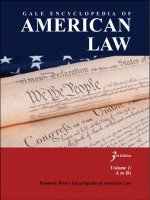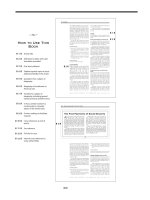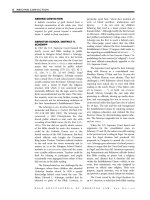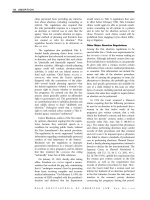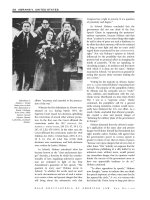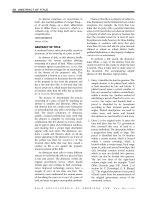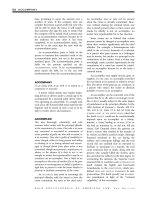Gale Encyclopedia Of American Law 3Rd Edition Volume 1 P50 ppt
Bạn đang xem bản rút gọn của tài liệu. Xem và tải ngay bản đầy đủ của tài liệu tại đây (445.54 KB, 10 trang )
establishments; in job opportunities, raises, and
promotions; and in the use of pub l ic schools
(Pub. L. No. 88-352, 78 Stat. 241).
While the Freedom Riders traveled across
the South, SNCC also pursued voter registra-
tion. In 1963 Baker went to Mississippi to help
with the Freedom Vote, a project of CORE and
SNCC. The Freedom Vote was a mock election
intended to demonstrate that, contrary to the
opinions held by many white southerners,
blacks were interested in voting. Baker assisted
the project by speaking at rallies, setting up
polling places, and collecting and counting the
ballots on voting day. The Freedom Vote was a
big success: More than 80,000 of the 90,000
people who cast ballots that day were black,
even though only around 20,000 blacks were
registered for real elections. Two years later, in
August 1965, the efforts of Baker and thousands
of other activists bore fruit when the Voting
Rights Act (Pub. L. No. 89-110, 79 Stat. 437)
was passed. The Voting Rights Act nearly
eliminated one of the last ways that had been
used to prevent African Americans from
voting—the literacy test—by prohibiting its
use in states where fewer than 50 percent of
eligible voters were registered.
In 1964 Baker again helped organize a civil
rights group. The group was the Mississippi
Freedom
DEMOCRATIC PARTY (MFDP), begun in
response to an established political party, the
Mississippi Democratic party. The MFDP
attempted to represent the state of Mississippi
at the 1964 Democratic National Convention in
Atlantic City, New Jersey, by claiming that, as
an interracial group, it was better able to do so
than the all-white Mississippi Democratic party.
HUBERT H. HUMPHREY, vice PRESIDENT OF THE UNITED
STATES
, and Walter F. Mondale, Minnesota
attorney general, suggested a compromise:
Two MFDP members could be named as
delegates to the convention, but would not be
part of Mississippi’s delegation. The MFDP
refused this offer, but its request was the catalyst
for a new rule passed by the national Demo-
cratic party, that all state delegations would have
to be racially mixed.
After achieving notable successes in the U.S.
civil rights movement, Baker continued to serve as
SNCC’s mentor as the organization became
involved in protests against the
VIETNAM WAR,and
as an advocate for the free speech movement
and women’s rights. She also worked toward
increased civil rights for blacks in other countries,
including the former Southern Rhodesia, now
Zimbabwe; South Africa; and Puerto Rico.
Baker died in New York City on December 13,
1986, her eighty-third birthday. By that time, some
of the organizations she had been involved with no
longer existed. SNCC fell apart after dissension
developed over black power, or black indepen-
dence from white America. The MFDP lasted
through the 1967 elections, winning offices in
local races, but was no longer needed after African
Americans were allowed to join the state Demo-
cratic party. Baker’s work, however, lives on in a
generation of black U.S. leaders she nurtured and
encouraged, who are able to carry on the struggle
for civil and
HUMAN RIGHTS worldwide.
FURTHER READINGS
Collins, Gail. 2007. “The Women behind the Men.” The New
York Times (September 22). Available online at http://
www.nytimes.com/2007/09/22/opinion/22collins.html?
_r=1&em&ex=1190606400&en=a20518e610336452&ei=
5087%0A; website home page:
(accessed August 28, 2009).
Dallard, Shyrlee, and Andrew Young. 1990. Ella Baker: A
Leader behind the Scenes. Englewood Cliffs, NJ: Silver
Burdett.
Ransby, Barbara. 2003. Ella Baker and the Black Freedom
Movement. Chapel Hill: Univ. of North Carolina Press.
CROSS REFERENCES
School Desegregation; Voting.
BAKER V. CARR
The ideal of ONE PERSON, ONE VOTE motivated the
founders of the United States of America to
establish a census when they drafted the U.S.
Constitution in 1787. Although that ideal has not
yet been fully realized—because the census still
undercounts racial and ethnic minorities, among
others—the country took a giant step closer to
equal representation for every citizen nearly two
centuries later, during the era of the
CIVIL RIGHTS
MOVEMENT
. On March 26, 1962, the U.S. Supreme
Court ruled in the landmark case of Baker v. Carr,
369 U.S. 186, 82 S. Ct. 691, 7 L. Ed. 2d 663 (1962),
that state legislative
APPORTIONMENT cases could be
reviewed by the federal courts. As a result, lawsuits
challenging the constitutionality of the apportion-
ment of legislative districts were filed in many
states. In a ruling that Chief Justice
EARL WARREN
later called the mostimportant of his tenure on the
Court, Justice
WILLIAM J. BRENNAN JR.wrote:
“Acitizen’s right to vote free of arbitrary impair-
ment by state action has been judicially recog-
nized as a right secured by the Constitution.”
GALE ENCYCLOPEDIA OF AMERICAN LAW, 3RD E DITION
478 BAKER V. CARR
Also significant because it examined the
notion of “political questions” and whether
courts could address them, the Baker v. Carr
case became a springboard for future appor-
tionment lawsuits. In June 1964, the Supreme
Court ruled on appeals from 15 states that had
used Baker as a
PRECEDENT, holding that both
houses of a state legislature must be appo r-
tioned substantially on the basis of population.
Within two years, every state had taken some
type of apportionment action. By the late 1960s,
congressional districts around the country had
been redrawn to meet the Supreme Court’s call
for equal representation, and after the 1970
census, underrepresented urban areas were
finally given an equal voice in Congress.
Every decade since 1790, U.S. citizens have
complied with the Constitution and counted
themselves. Whereas on its simplest level the
census is a means to document historical
changes in the U.S. population, it also deter-
mines how federal funds, power, political clout,
and representation are divided, or apportioned,
among the people of the United States. The
notion of representation, more specifically equal
representation, compelled Charles W. Baker
and other qualified voters in Tenn essee to bring
a lawsuit against Tennessee’s
SECRETARY OF STATE
Joe C. Carr, on the grounds that the state’s 1901
apportionment statute (Acts Tenn. 1901, c. 122)
violated the
FOURTEENTH AMENDMENT of the
Constitution. The plaintiffs argued that Ten-
nessee’s method of unequally apportioning the
members of the general assembly among the
state’s 95 counties unconstitutionally deprived
people in the state of
EQUAL PROTECTION of the
laws and was obsolete because of a significant
growth and population shift since 190 0.
The plaintiffs’ first round in court brought
failure when a three-judge panel of the U.S.
district court for the Middle District of Tennes-
see dismissed their complaint on December 21,
1959 (Baker, 179 F. Supp. 824). The panel
dismissed the complaint on two grounds: (1)
that the court lacked jurisdiction of the subject
matter because it was a
POLITICAL QUESTION and (2)
that the complaint failed to state a claim upon
which relief could be granted.
The plaintiffs appealed, and on November
21, 1964, the U.S. Supreme Court ruled that it
had probable jurisdiction in the matter. This
State Legislative Apportionment Before Baker v. Carr
a
a
Nebraska has a unicameral legislature (only one legislative chamber), and, therefore, is not represented on this graph. Nebraska's
legislature was apportioned by population.
SOURCE: Gordon E. Baker, State Constitutions: Rea
pp
ortionment
(
New York: National Munici
p
al Lea
g
ue, 1960
)
, 5.
Equal apportionment
for each unit
1 state
Fixed constitutional
apportionment
1 state
Population
only
12 states
a
Combination of
population and area
28 states
Population,
but with
weighted
ratios
7 states
Houses
Fixed constitutional
apportionment
4 states
Apportionment by
taxation
1 state
Population, but with
weighted ratios
1 state
Population
only
19 states
a
Combination of
population and area
17 states
Equal
apportionment
for each unit
7 states
Senates
ILLUSTRATION BY GGS
CREATIVE RESOURCES.
REPRODUCED BY
PERMISSION OF GALE,
A PART OF CENGAGE
LEARNING.
GALE ENCYCLOPEDIA OF AMERICAN LAW, 3
RD E DITION
BAKER V. CARR 479
decision was significant because before the
Supreme Court heard the Baker case, courts
had abstained from addressing apportionment
issues because they were considered political in
nature. In the 1946 Supreme Court case
Colegrove v. Green, 328 U.S. 549, 66 S. Ct.
1198, 90 L. Ed. 1432 (1946), Justice
FELIX
FRANKFURTER
called apportionment a “political
thicket” into which the judiciary should not
venture. The subsequent ruling in Baker chan-
ged that interpretatio n, stating that federal
courts possessed jurisdiction of the subject, that
the citizens in Tennessee were entitled to relief,
and that the federal district court in the state
could settle the challenge to the apportionment
statute of Tennessee.
In addressing the concern of some of his
fellow Supreme Court justices who warned
that the matter before them was a political
question and therefore not appropriately dealt
with in a court of law, Justice Brennan carefully
wrote—and rewrote, ten times—his opinion in
the 1962 decision. Brennan stated: “The mere
fact that the suit seeks protection of a political
right does not mean it presents a political
question. Such an objection is little more than a
play upon words.” He added that the plaintiffs’
complaint did present a
JUSTICIABLE constitution-
al
CAUSE OF ACTION and that the Fourteenth
Amendment did provide judicial protection to
the right asserted. Justices Frankfurter and
JOHN
MARSHALL HARLAN
dissented, stating that Brennan
should not inject the Court “into the clash of
political forces and political settlements.” The
Court’s 6-2 ruling in favor of the plaintiffs
forced state legislatures to reapportion their
seats to reflect population shifts before the
elections that were to occur in the fall of 1962. It
also decreed one person, one vote as part of the
United States’ constitutional heritage and
opened the door to challenging state voting
procedures and malapportionment on constitu-
tional grounds.
In his book Turning Point: A Candidate, a
State, and a Nation Come of Age, former
president
JIMMY CARTER described how revolu-
tionary the Baker decision was in the 1960s and
how it transformed state politics, especially
southern politics. Carter wrote that the Georgia
state government, like many others, proposed a
number of stalling ploys, fake reapportionment
plans, and other ways to avoid the shift in
political power that the one-person, one-vote
ruling had been designed to cause. “The
beneficiaries of the [old] system were the ones
now charged with changing it,” he wrote. “At
the same time, they woul d be reducing
drastically the relative voting strength of their
own constituents. It was understandable that
[they] would do everything possible to circum-
vent or postpone the effect of the court’s
mandate.” Federal judges rejected the bogus
plans, however, and by late summer 1962, the
state’s political process had been thrown wide
open. Incumbent politicians were suddenly
without districts, and new seats had opened
up. In these circumstances, a few weeks before
the election, Carter decided to run for the
Georgia State Senate.
FURTHER READINGS
Charles, Guy-Uriel E. 2002. “Constitutional Pluralism and
Democratic Politics: Reflections on the Interpretive
Approach of Baker and Carr.” North Carolina Law
Review 80 (May).
“A Final Victory Marks the End of a Career.” 1990. National
Law Journal (August 13).
Fuentes-Rohwer, Luis. 2002. “Baker’s Promise, Equal
Protection, and the Modern Redistricting Revolution:
A Plea for Rationality.” North Carolina Law Review 80
(May).
“Koohi v. United States.” 1993. Georgia Law Review 28 (fall).
Pushaw, Robert J., Jr. 2001. “Bush v. Gore: Looking at Baker
v. Carr in a Conservative Mirror.” Constitutional
Commentary 18 (summer).
Richie, Robert, and Steven Hill. 1999. Reflecting All of Us:
The Case of Proportional Representation. Boston:
Beacon.
Rush, Mark E. 1993. Does Redistricting Make a Difference?
Partisan Representation and Electoral Behavior. Balti-
more: Johns Hopkins Univ. Press.
“Some Implications of Arrow’s Theorem for Voting Rights.”
1995. Stanford Law Review 47 (January).
“The Trustees of the Office of Hawaiian Affairs v. Yamasaki:
The Application of the Political Question Doctrine to
Hawaii’s Public Land Trust Dispute.” 1988. University
of Hawaii Law Review 10 (winter).
“United States v. Alvarez-Machain: Waltzing with the
Political Question Doctrine.” 1994. Connecticut Law
Review 26 (winter).
“U.S. Supreme Court.” 1990. National Law Journal (June 4).
“When Restraint Requires Activism.” 1990. Stanford Law
Review 42 (July).
CROSS REFERENCES
Apportionment; Brennan, William Joseph, Jr.; Equal
Protection; Failure to State a Claim; Fourteenth Amend-
ment; Frankfurter, Felix; Political Question; Reynolds v.
Sims; Voting.
BAKKE AFFIRMATIVE ACTION CASE
See REGENTS OF THE UNIVERSITY OF CALIFORNIA V.
BAKKE.
GALE ENCYCLOPEDIA OF AMERICAN LAW, 3RD E DITION
480 BAKKE AFFIRMATIVE ACTION CASE
BALANCE SHEET
A comprehensive financial stat ement that is a
summarized assessment of a company’s accounts
specifying its assets and liabilities. A report,
usually prepared by independent auditors or
accountants, which includes a full and complete
statement of all receipts and disbursements of a
particular business. A review that shows a general
balance or summation of all accounts without
showing the particular items that make up the
several accounts.
BALANCING
A process sometimes used by state and federal
courts in deciding between the competing interests
represented in a case.
Used frequently to decide constitutional
cases, balancing is one of two main legal
decision-making methods, the other being
categorization or
STRICT CONSTRUCTION. Balancing
involves weighing competing rights against each
other and analyzing the relative strength s of
many factors. A balancing decision is dependent
upon the circumstances of each case. Therefore,
the outcome is difficult to predict. By contrast,
categorization is a classification and labeling
process. It involves identifying a right and how
it was infringed upon and analogizing these
findings to a previously decided case or
PRECE-
DENT
. Hence, the outcome is more predictable.
Balancing of Competing Interests
in the U.S. Supreme Court
Balancing may take one of two forms in cases
before the U.S. Supreme Court. In the first, the
Court may measure competing interests against
each other and determine which carries the
most weight. For example, in New York v.
Ferber, 458 U.S. 747, 102 S. Ct. 3348, 73 L. Ed.
2d 1113 (1982), the Court upheld a statute
criminalizing distribution of
CHILD PORNOGRAPHY
because the evil eliminated by the statute far
outweighed any infringement on free speech
interests. In the second form of balancing, the
Court attempts to “strike a balance” between
competing interests. Thus, in Tennessee v.
Garner, 471 U.S. 1, 105 S. Ct. 1694, 85 L. Ed.
2d 1 (1985), the Court held that a police officer
may use
DEADLY FORCE to stop a fleeing felon if
the officer has
PROBABLE CAUSE to believe that the
suspect poses a threat of serious physical harm
to others. In Garner, the Court did not find that
one interest clearly outweighed the other.
Instead, both the state’s interest in law enforce-
ment and the individual’s interest in being free
from harm were weighed in the analysis and
given due recognition.
Balancing was first used by the U.S.
Supreme Court as one of its principal modes
of judicial analysis in the late 1930s and early
1940s when the judiciary began to reject the
rigid formalism and mechanical
JURISPRUDENCE
characteristic of the nineteenth and early
twentieth centuries. Before the balancing era
began in earnest with
LOCHNER V. NEW YORK, 198
U.S. 45, 25 S. Ct. 539, 49 L. Ed. 937 (1905), the
Court held that a New York statute setting
maximum work hours was constitutional be-
cause such regulation was within the state’s
POLICE POWER. In reaching this decision, the
Court did not attempt to balance the rights of
the individuals against the state’s interests, but it
took a straightforward look at the language of
the statu te and found it valid. This earlier Court
stated: “The purpose of a statute must be
determined from the natural and legal effect
of the language employed It seems to us
that the real object and purpose [of the statute]
were simply to regulate the hours of labor
between the master and his employees.”
Early proponents of balancing included
such prominent Supreme Court justices as
Oliver Wendell Holmes Jr.,
LOUIS D. BRANDEIS,
and
HARLAN F. STONE, all of whom sat on the
Court in the early to middle 1900s. Holm es,
sometimes called the patron saint of the anti-
formalist movement, was one of the first to
espouse the idea that the law is and should be an
evolving product of social experience. He
assailed the notion that rigid formulas could
be applied to all situations before the Court.
“[T]he law is a logical development, like
everything else,” he wrote. In a similar vein,
Brandeis criticized the Court for ignoring
contemporary social, political, and economic
problems. He said, “[W]hether a measure
relating to the public
WELFARE is arbitrary or
unreasonable should be based upon a
consideration of relevant facts, actual or possi-
ble” (Adams v. Tanner, 244 U.S. 590, 37 S. Ct.
662, 61 L. Ed. 1336 [1917] [Brandeis, J.,
dissenting]). In another case, he wrote: “Wheth-
er a law enacted in the exercise of the police
power is justly subject to the charge of being
unreasonable or arbitrary can ordinarily be
determined only by a consideration of the
contemporary conditions, social, industrial,
GALE ENCYCLOPEDIA OF AMERICAN LAW, 3RD E DITION
BALANCING 481
and political, of the commun ity to be affected
thereby. Resort to such facts is necessary, among
other things, in order to appreciate the evils
sought to be remedied and the possible effects
of the remedy proposed” (Truax v. Corrigan,
257 U.S. 312, 42 S. Ct. 124, 66 L. Ed. 254 [1921]
[Brandeis, J., dissenting]). Similarly, Stone
forcefully advocated “consideration of all the
facts and circumstances” in a case, including
societal conditions that affected the parties, the
controversy, and the outcome (DiSanto v.
Pennsylvania, 273 U.S. 34, 47 S. Ct. 267, 71 L.
Ed. 524 [1927][Stone, J., dissenting]).
The Court uses a balancing approach most
often to decide cases where constitutionally
protected individual rights conflict with gov-
ernmental interests. Many of the landmark
constitutional cases of the 1960s, 1970s, and
1980s were decided in this manner, including
ROE V. WADE, 410 U.S. 113, 93 S. Ct. 705, 35 L.
Ed. 2d 47 (1973), which legalized
ABORTION.In
reaching its decision in Roe, the Court found
that in the first trimester of pregnancy, a
woman’s right to privacy outweighed the state’s
interest in protecting health, but in the later
stages of pregnancy, the state’s interest gradually
outweighed the woman’s.
Contrary to popular belief, however, the
Court has not used balancing as its primary
method of deciding constitutional cases. In fact,
some of the most important constitutional
cases of the twentieth century were decided
without any balancing of competing interests.
For example, balancing was not used to decide
BROWN V. BOARD OF EDUCATION, 347 U.S. 483, 74 S.
Ct. 686, 98 L. Ed. 873 (1954) (outlawing
segregated public schools);
GIDEON V. WAINWRIGHT,
372 U.S. 335, 83 S. Ct. 792, 9 L. Ed. 2d 799
(1963) (guaranteeing indigent defendants
appointed counsel in felony cases); and
GRISWOLD
V
. CONNECTICUT, 381 U.S. 479, 85 S. Ct. 1678, 14
L. Ed. 2d 510 (1965) (outlawing state laws
prohibiting contraceptives).
Balancing has always aroused controversy
among legal scholars and judges. Critics con-
tend that it gives too much discretion to judges
and amounts to a
USURPATION of the legislative
function. They maintain that it is a vague and
arbitrary method of measuring unequal inter-
ests against each other and that it results in
unpredictable decision making. One vocal critic
of balancing is Justice
ANTONIN SCALIA.Inhis
dissenting opinion in Bendix Autolite Corp. v.
Midwesco Enterprises, 486 U.S. 888, 108 S. Ct.
2218, 100 L. Ed. 2d 896 (1988), he characterized
the balancing of competing interests as an
illusion. “[T]he scale analogy is not really
appropriate,” he wrote, “since the interests on
both sides are incommensurate. It is more like
judging whether a particular line is longer than
a particular rock is heavy.”
Scalia’s frontal attack on balancing gained
force in the 1990s when Scalia was joined on the
Court by other justices who shared his philoso-
phy that the Constitution should be construed
strictly and literally. Evidence that Scalia’s view
was held by others on the Court can be found in
the 1995 decision Vernonia School District 47J v.
Acton, 515 U.S.646, 115 S. Ct. 2386, 132 L. Ed.
2d 564 (U.S. 1995), which held that schools
could legally perform random drug tests on
student athletes. The decision employed a
straightforward analysis of the rationality of
the school’s policy to conduct random drug
tests and dismissed concerns about infringe-
ment of the students’
FOURTH AMENDMENT right
to be free from unreasonable searches. Writing
for the majority, Scalia stated: “The most
significant element in this case is that the
policy was undertaken in furtherance of the
government’s responsibilities, under a public
school system, as guardian and tutor of children
entrusted to its care.” The Court held that the
testing was a type of search that “a reasonable
guardian and tutor might undertake.”
Three justices disagreed vehemently. Writ-
ing for the dissent, Justice Sandra Day O’Connor
emphasized her belief that the decision did not
give due recognition to the students’ constitu-
tional rights and went too far in its broad
approval of “intrusive, blanket searches of
school children, most of whom are innocent,
for evidence of serious wrongdoing.” Under
the ruling, she said, students no longer enjoyed
“the Fourth Amendment’s most basic
protection: its strong preference for an individu-
alized suspicion requirement.”
Justice O’Connor’s dissent in Acton echoed
her strong approval of balancing competing
interests and assessing a statute’s intrusion on
individual rights. O’Connor expressed her belief
that balancing is an essential step in the Court’s
decision-making process, in Employment Divi-
sion, Department of Human Resources v. Smith,
494 U.S. 872, 110 S. Ct. 1595, 108 L. Ed. 2d 876
(1990). The respondents in Smith were Native
Americans who were fired from their jobs
because they ingested peyote as part of a
GALE ENCYCLOPEDIA OF AMERICAN LAW, 3RD E DITION
482 BALANCING
religious ceremony. The Court held that the
state could deny them unemployment benefits
without violating the Free Exercise Clause of
the
FIRST AMENDMENT.O’Connor concurred with
the result but took issue with the majority’s
failure to consider the effect the disputed statu te
had on the free exercise of
RELIGION. “To me,”
O’Connor wrote, “the sounder approach—the
approach more consistent with our role as
judges to decide each case on its individual
merits—is to apply [a] test in each case to
determine whether the burden on the specific
plaintiffs before us is constitutionally significant
and whether the particular interest asserted
by the State before us is compelling.”
Balancing of Competing Interests in
Other State and Federal Courts
Although the U.S. Supreme Court generates
close scrutiny of its decisions when it applies a
balancing test to resolve high-profile or contro-
versial issues before it, it is not the only court
that resolves issues by balancing competing
interests at stake in a legal dispute. Indeed, every
day across the country state and federal courts
are asked to balance the competing interests of
litigants in determining the admissibility of
evidence, the appropriateness of a sentence, or
the viability of an appeal.
For example, state and
FEDERAL RULES OF
EVIDENCE
call for the exclusion of relevant
evidence when its probative value is substantial-
ly outweighed by the danger of unfair prejudice
or by considerations of undue delay, waste of
time, or the needless presentation of cumulative
or confusing evidence. Consequently, before
one party may introduce relevant evidence over
another party’s
OBJECTION, the judge must
balance the competing interests that would be
served by excluding or admitting the evidence
in question.
State and federal
SENTENCING guidelines also
generally require judges to balance the aggra-
vating and
MITIGATING CIRCUMSTANCES underlying
a criminal offen se before imposing a particular
sentence on a
DEFENDANT. Aggravating factors
are those factors that justify a more severe
punishment and are typically introduced by
the prosecution, victim, or victim’s family.
Mitigating factors are those factors that justify
a less severe sentence and are typically intro-
duced by the defendant, the defendant’s
ATTOR-
NEY
,orWITNESSES speaking on behalf of the
defendant.
Finally, appellate courts often
ENGAGE in
some form of balancing to review the lawfulness
of a lower court decision. In addition, to the
above examples from the U.S. Supreme Court,
appellate courts employ a variety of standards of
review by which they evaluate the record for
error using some form of balancing analysis. For
example, the substantial evidence standard of
review requires appellate courts to determine if
a lower court’s decision was supported by
sufficient evidence to avoid being overturned,
meaning that the appellate court must weigh the
evidence offered by the parties to some extent.
Appellate courts applying the arbitrary and
capricious standard of review must not only
examine the gravity of the alleged arbitrary or
capricious conduct in the lower court, but they
must also take into consideration any evidence
that makes the lower court’s decision reasonable
or justifiable.
FURTHER READINGS
Alexy, Robert. 2003. “Constitutional Rights, Balancing, and
Rationality.” Ratio Juris 16, vol. 2 (June).
Gottlieb, Stephen E., ed. 1993. Public Values in Constitution-
al Law. Ann Arbor, MI: Univ. of Michigan Press.
McKenna, George. 2007. The Constitution: That Delicate
Balance. New York: Random House.
CROSS REFERENCES
Child Pornography; Deadly Force; Fourth Amendment;
Judicial Review; Jurisprudence; Police Power; Precedent;
Probable Cause; Strict Construction.
v
BALDWIN, HENRY
Henry Baldwin w as a prominent Pennsylvania
ATTORNEY and politician who later became an
ASSOCIATE JUSTICE of the U.S. Supreme Court,
where he served for fourteen years.
Descended from an aristocratic British
family dating back to the seventeenth century,
Baldwin was born January 14, 1780, in New
Haven, Connecticut. He grew up on a farm near
New Haven and later moved to the city to
attend Yale College. After graduating with
honors in 1797, he studied law in Philadelphia
with
ALEXANDER J. DALLAS, a noted attorney.
Admitted to the bar a short time later, Baldwin
originally planned to establish a practice in
Ohio, but instead settled in Pittsburgh. He then
established a successful law firm with two other
young attorneys. By his mid-20s, Baldwin had
established a reputation as a legal scholar, in
part because of his thorough and well-
researched law briefs. He had also developed
WORDS ARE BUT THE
EVIDENCE OF
INTENTION
; THEIR
IMPORT IS THEIR
MEANING
, TO BE
GATHERED FROM THE
CONTEXT
, AND THEIR
CONNECTION WITH
THE SUBJECT
MATTER
.
—HENRY BALDWIN
GALE ENCYCLOPEDIA OF AMERICAN LAW, 3RD E DITION
BALDWIN, HENRY 483
an extensive personal la w library, which con-
tained a large collection of valuable English case
reports and was among the finest and largest in
the Northeast. Furthermore, Baldwin and his
law partners were known for their political and
civic leadership. The three publish ed a news-
paper, the Tree of Liberty, which supported the
REPUBLICAN PARTY of western Pennsylvania. In
addition to his political activities and his law
practice, Baldwin found time for business,
acting as part-owner of several mills in
Pennsylvania and Ohio.
After the death of his first wife, Baldwin
married Sally Ellicott, and they established a
residence in Crawford County, Pennsylvania. In
1816 Baldwin was elected representative to the
U.S. Congress for that area. As a congressman,
Baldwin was active in trade issues and was a
strong advocate of
TARIFF protection. He was
also involved in mediating boundary disputes
between northern and southern states and their
representatives. He was twice reelected to the
House. In 1822 he was forced to resign his seat
because of illness. He returned home to
Pennsylvania, where he once again practiced
law and was active in local political affairs.
Baldwin soon became an avid supporter of
ANDREW JACKSON and was a trusted adviser to
Jackson concerning Pennsylvania politics. After
Jackson was elected president in 1828, Baldwin
hoped to become secretary of the treasury, but
the appointment instead went to Samuel D.
Ingham. The following year, after the death of
Justice
BUSHROD WASHINGTON, Jackson nomi-
nated Baldwin to the U.S. Supreme Court,
against the wishes of his
VICE PRESIDENT, JOHN C.
CALHOUN, who preferred another candidate.
Though Baldwin’s protectionist views created
some controversy, he was confirmed by the
Senate with only two dissenting votes from
southern senators who opposed his policies on
tariffs.
On the bench, Baldwin was at first a strong
supporter of the liberal views of Chief Justice
JOHN MARSHALL but gradually moved toward a
more moderate interpretation of the Constitu-
tion, favoring neither state sovereignty nor
federal supremacy. In 1837 he published a
pamphlet, A General View of the Origin and
Nature of the Constitution and Government of the
United States, in which he set forth what he
termed his “peculiar views of the Constitution.”
In this work, he emphasized his position as a
moderate on the Court, stating that he tended
to take the Constitution “as it is, and to
expound it by the accepte d rules of interpreta-
tion.” Baldwin also believed that the Court must
Henry Baldwin 1780–1844
◆◆◆
◆
❖
❖
1837 A General
View of the
Origin and Nature
of the Constitution
and Government of
the United States
published
1844 Died,
Philadelphia, Pa.
1816–22
Represented
Pennsylvania in
U.S. House of
Representatives
1829 Nominated to
U.S. Supreme Court
by Andrew Jackson
1775–83 American
Revolution
1780 Born, New
Haven, Conn.
1787 Pennsylvania
ratified U.S.
Constitution
1797 Received LL.D.
from Yale University
▼▼
▼▼
1775
1850
1825
1800
Henry Baldwin.
THOMAS SULLY,
COLLECTION OF THE
SUPREME COURT OF
THE UNITED STATES
GALE ENCYCLOPEDIA OF AMERICAN LAW, 3RD E DITION
484 BALDWIN, HENRY
be politically sensitive when determ ining which
powers belonged to the federal government and
which remained with the states.
One of Baldwin’s most influential majority
opinions was United States v. Arredondo, 31 U.S.
691, 6 Pet. 691, 8 L. Ed. 547 (1832), in which the
Court held that
PUBLIC POLICY prevented the
government from violating federal land treaties.
With respect to the issue of
SLAVERY,however,
Baldwin’s views were considered to be much more
radical than those held by other members of the
Court. In Groves v. Slaughter, 40 U.S. 449, 15 Pet.
449,10 L.Ed.800 (1841), the Court considered the
constitutionality of a Mississippi provision that
prevented the importation of slaves into the state.
The Court ultimately struck down the statute on
technical reasons, but Baldwin, in a separate
opinion, argued that slaves were property as well as
persons and viewed the prohibition as an
obstruction of interstate commerce. He was the
sole dissenter in United States v. The Schooner
Armistead, 40 U.S. 518, 15 Pet. 518, 10 L. Ed. 826
(1841), in which the Court held that slaves who
had mutinied and taken over the slave ship
transporting them from Africa should be set free.
Though he did not write an opinion, Baldwin had
earlier maintained that the slaves should be
returned to the custody of the slave traders.
As was the practice in the Court at the time,
Baldwin traveled the circuit he represen ted,
which included Pennsylvania and New Jersey, to
hear cases. He heard important cases involving
the construction of a will that made a bequest
for charitable purposes and also presided over
the trial of John F. Braddel, who in 1840 was
accused of robbi ng the mails.
In his later years, Baldwin was plagued by
financial and personal difficulties. He never fully
recovered from losing a great deal of money
during the depression of 1820. He also suffered
from the failure of several speculative businesses,
and he had to support some of his adult children
when they got into financial trouble. He was
eventually forced to sell his renowned personal law
library to the
LIBRARY OF CONGRESS to raise money.
He also published and sold volumes of the
opinions he decided while traveling the circuit.
At the same time, Baldwin’s behavior became
erratic and he was widely reported to be suffering
from mental illness. While on the bench, he was
often restless, inattentive, and abusive to litigants
and his fellow justices. While on the circuit, he
also exhibited bizarre behavior at times, often
having coffee and cakes brought to him while he
heard cases. Chief Justice
ROGER B. TANEY was
reported to be so concerned about Baldwin’s
unpredictable behavior that he advised President
Jackson not to take action against the
BANK OF THE
UNITED STATES
because Baldwin, as presiding judge
over the case in Philadelphia, would be unreliable.
Baldwin’s tenure on the Court ended on
April 21, 1844, when he died of paralysis at the
age of sixty-four. He was deeply in debt at the
time of his death, and friends and family took
up a collection to pay for his funeral expenses.
FURTHER READINGS
Congressional Quarterly. 1989. Guide to the U.S. Supreme
Court. 2d ed. Washington, D.C.: Congressional
Quarterly.
Elliott, Stephen P., ed. 1986. A Reference Guide to the United
States Supreme Court. New York: Facts on File.
Swisher, Carl B. 1974. The Taney Period, 1836–1864. Vol. 5
of History of the Supreme Court of the United States.
New York: Macmillan.
v
BALDWIN, JOSEPH GLOVER
Joseph Glover Baldwin achieved prominence as
a jurist and author despite his lack of formal
education.
Joseph Glover Baldwin 1815–1864
◆◆
◆
◆
◆◆
❖
❖
1815 Born near
Winchester, Va.
1817 Mississippi
gained statehood
1819 Alabama
gained statehood
1836 Established
legal practice in
DeKalb, Miss.
1853 The Flush Times
of Alabama and
Mississippi published
1850
California gained
statehood
1854 Moved to
San Francisco, Ca.
1844–49
Served as
Alabama state
legislator
1858–62 Served as
associate justice
of the California
Supreme Court
1861–65
U.S. Civil War
1864 Died, San
Francisco, Ca.
▼▼
▼▼
18001800
18751875
18501850
18251825
GALE ENCYCLOPEDIA OF AMERICAN LAW, 3RD E DITION
BALDWIN, JOSEPH GLOVER 485
Baldwin was born in January, 1815, near
Winchester, Virginia. After establishing a legal
practice in 1836 in DeKalb, Mississippi, he
relocated to Alabama and entered the legislature
of the state in 1844, serving for five years.
In 1854 Baldwin moved again, this time to
San Francisco. He maintained a successful
practice and was involved in the formulation
of the judicial system of San Francisco. He
officially entered the judiciary in 1858, presiding
as
ASSOCIATE JUSTICE of the California Supreme
Court until 1862.
As an author, Baldwin is famous for The
Flush Times of Alabama and Mississippi (1853)
and Party Leaders (1855). He died September
30, 1864, in San Francisco, California.
v
BALDWIN, ROGER NASH
Roger Nash Baldwin spent his life crusading for
CIVIL RIGHTS and liberties and was one of the
principal founders of the
AMERICAN CIVIL LIBERTIES
UNION
(ACLU).
Baldwin was born January 21, 1884, in
Wellesley, Massachusetts, into a comfortably
well-to-do Boston Brahmin family. His ances-
tral roots reached back to what he once referred
to as “the inescapable Mayflower.” His father,
Frank Fenno Baldwin, was a conservative
businessman. His mother, Lucy Cushing Nash,
instilled in her children a love of art, literature,
and musi c. Baldwin’s parents raised their six
children with all the privileges and advantages
their wealth could provide, but they also
emphasized service to others. The family
attended the Unitarian Church, where an
emphasis on helping others sowed in Baldwin
the seeds of a social work career.
Baldwin was an unconventional boy who
was not interested in competitive endeavors and
shared his mother’s interest in literature and art.
He was a nonconformist who was influenced by
Henry David Thoreau’s philosophy of individu-
alism and self-reliance. Although his parents
were conservative, the young Baldwin was
introduced to many progressive leaders at the
home of his uncle and aunt, William Baldwin
and Ruth Standish Bowles Baldwin. His uncle
was president of the Long Island Railroad,
director of the National Child Labor Commit-
tee, and a
TRUSTEE of Tuskegee Institute. He also
worked to end prostitution,. His aunt supported
the fledgling labor movement and was a
founder of the
NATIONAL URBAN LEAGUE, a trustee
of Smith College, and a member of the
SOCIALIST
PARTY
. The couple often entertained the social
reformers of the day, and Baldwi n was influ-
enced by his exposure to their somewhat radical
ideas.
Baldwin was educated at Harvard, earning
both a bachelor’s degree and a master’s degree
there. In 1906 he left the East and headed for
St. Louis to be a social worker. He directed a
social settlement house for poor people and
taught the first sociology courses offered at
Washington University, in St. Louis. He became
the chief probation officer of the St. Louis
Juvenile Court in 1908. While in that position,
he and Bernard Flexner coauthored the first
textbook on the juvenile courts. Their book,
Juvenile Courts and Probation, set out profes-
sional standards for juvenile practice and was
the standard text in the field until the 1960s. In
1910 Baldwin became the secretary of the St.
Louis Civic League, an urban reform agency
supporting civic causes.
Roger Nash Baldwin 1884–1981
◆◆◆◆◆◆◆◆
❖
❖
1961–73
Vietnam War
1981 Awarded
Medal of Freedom;
died, Oakland, N.J.
1940 All communist members
of ACLU board removed
1939–45
World War II
1950 Retired
as director of
ACLU
1925 ACLU
joined defense
team of Scopes
"Monkey" trial
1920 Helped organize and
became first director of ACLU
1917 Organized American
Union Against Militarism
1914–18
World War I
1914 Juvenile Courts and
Probation published
1904 Graduated
from Harvard
University
1908 Became chief
probation officer of the
St. Louis Juvenile Court
1884 Born,
Wellesley, Mass.
▼▼
▼▼
19001900
18801880
19251925
19501950
19751975
GALE ENCYCLOPEDIA OF AMERICAN LAW, 3RD E DITION
486 BALDWIN, ROGER NASH
While working in St. Louis, Baldwin met and
became friends with the anarchist EMMA GOLDMAN.
His first defense of free speech came in 1912
when he spoke in support of
MARGARET SANGER,an
early crusader for
BIRTH CONTROL and reproduc-
tive rights, whose lecture was shut down by the
police. Through the social work profession he
was attracted to the reform movement and the
labor movement. He organized the Division on
Industrial and Economic Problems at the 1916
meeting of the National Conference of Social
Work, and wrote a report calling for cooperative
production and distribution systems to replace
competitive labor systems.
In 1917, when the United States entered
WORLD WAR I, Baldwin organized the American
Union against Militarism (AUAM), which was
later replaced by the National Civil Liberties
Bureau (NCLB). In its early days, the AUAM
was concerned with defending those who
refused to be drafted to serve in the war.
Baldwin was among the conscientious objectors
opposed to the draft, and he was sentenced to a
year in jail for his refusal to register. In a speech
to the court before he was sentenced, he
explained that his reason for opposing the draft
was his “uncompromising opposition to the
principle of
CONSCRIPTION of life by the state for
any purpose whatever, in time of war or peace.”
After his release from prison, Baldwin
worked as a common laborer around the
Midwest and joined the radical International
Workers of the World (IWW) union. He
returned to New York in 1920 to help reorganize
and reconstitute the NCLB with two conservative
lawyers, Albert DeSilver and Walter Nelles, who
shared his passion for championing the rights of
the oppressed. Baldwin agreed to head the new
organization, named the American Civil Liberties
Union, and carry out its unique mission to
impartially defend the civil liberties of all U.S.
citizens, regardless of their affiliation or activities.
Baldwin was launched in what would be a long
and vigorous struggle to create “a society with a
minimum of compulsion, a maximum of
individual freedom and of voluntary association,
and the abolition of exploitation and poverty.”
Perhaps it was inevitable that Baldwin would
become associated with leftist causes, because the
people most in need of free speech protection
during the 1920s and 1930s were often political
liberals and radicals. He once told an interviewer
that during this time he was heavily influenced
by the Marxist theory that “the real center in
society was the organized underdog in the trade
unions,” which he believed was true although
only part of the whole picture.
Baldwin came to realize that the civil liberties
of right-wing groups were just as likely to be
infringed as those of left-wingers. Bewildered
and frustrated by liberal groups who opposed
the ACLU’s support of free speech rights for the
American Nazi party or the
KU KLUX KLAN,
Baldwin said, “[T]hese people can be just as
great tyrants as the other side helping them
get freedo m didn’t help the cause of freedom.”
Referring to the wide variety of causes the ACLU
defended over the years, Baldwin said, “I always
felt from the beginning that you had to defend
people you disliked and feared as well as those
you admired.” Although not a member of any
party, he supported the causes of Communists,
Socialists, and other leftist organizations during
the 1920s and 1930s. However, in 1940, when he
began to realize that the Communist label was
being used by totalitarian governments, he wrote
a resolution that resulted in the removal of all
the Communist members of the ACLU board.
Ironically, Baldwin’s resolution became the
model for government loyalty oaths, which the
ACLU later attacked in court.
Although he was a card-carrying Wobbly, as
members of the IWW were called, Baldwin
could not be categorized as liberal or conserva-
tive. He was active in the National Audubon
Society, the American Political Science Associa-
tion, and a number of other organizations on
both ends of the political spectrum. The only
label Baldwin accepted for himself was that of
reformer: “I am dead certain that human
progress depends on those heretics, rebels and
dreamers who have been my kin in spirit and
whose ‘holy discontent’ has challenged estab-
lished authority and created the expanding
visions mankind may yet realize .”
During the years of Baldwin’s leadership, the
ACLU, using volunteer lawyers, was involved in a
wide variety of civil liberties cases, especially
involving free speech and assembly. One con-
cerned a 1925 Tennessee law forbidding the
teaching of evolution in public schools. The
ACLU defended a science teacher, John Thomas
Scopes, charged with violating the law (Scopes v.
State, 152 Tenn. 424, 278 S.W. 57 [1925]; 154
Tenn. 105, 289 S.W. 363 [1927]).
WILLIAM JENNINGS
BRYAN
, a three-time presidential candidate and
well-known fundamentalist, helped the state
attorney general
PROSECUTE the case, and the
[OUR GOAL IS] A
SOCIETY WITH A
MINIMUM OF
COMPULSION
, A
MAXIMUM OF
INDIVIDUAL FREEDOM
AND OF VOLUNTARY
ASSOCIATION
, AND
THE ABOLITION OF
EXPLOITATION AND
POVERTY
.
—ROGER NASH
BALDWIN
GALE ENCYCLOPEDIA OF AMERICAN LAW, 3RD E DITION
BALDWIN, ROGER NASH 487

